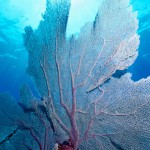Here, we will provide the basic information about corals for the reef aquarium. It was once thought that keeping corals in an aquarium was impossible, but over the years, with advancement of technique and technology, it has become much easier to care for coral in your saltwater aquarium! We will start with the basics in this article and continue with several articles getting into the specific needs of each of the seven main categories of corals for the reef aquarium. Join us, enjoy, and figure out which type of coral you’d like to keep in your beautiful home marine aquarium!
What are corals? Corals are actually animals! They may look like flowers and plants, but they are actually tiny creatures called polyps. These tiny polyps have tentacles that surround a mouth, digestive system, reproductive tract, and nervous system. The tentacles of each polyp are tipped with stinging cells called nematocysts that they use to defend themselves and capture food.
On a coral reef, th e polyps are not everything that you see. In fact, depending on the time of day that you visit the reef, you may not see any of the polyps at all! All corals secrete at least some amount of calcium carbonate as their byproduct. Calcium carbonate is the hard, shell-like byproduct of stony corals (Scleractinia) such as elkhorn coral, brain coral, staghorn coral, table coral, etc. that make up the skeleton structure that forms most of the visible reef. (“Scleractinia,” 2012)
e polyps are not everything that you see. In fact, depending on the time of day that you visit the reef, you may not see any of the polyps at all! All corals secrete at least some amount of calcium carbonate as their byproduct. Calcium carbonate is the hard, shell-like byproduct of stony corals (Scleractinia) such as elkhorn coral, brain coral, staghorn coral, table coral, etc. that make up the skeleton structure that forms most of the visible reef. (“Scleractinia,” 2012)
 Soft corals (Gorgonacea) such as sea fans and sea whips have a flexible skeleton that is made of a protein secretion called gorgonin. They do secrete some calcium carbonate, but only in small clumps. (“Gorgonian,” 2012) The polyps of these stony corals and soft corals generally live in colonies. The larger the colony of polyps, the larger the skeletal structure. Entire colonies can weigh several tons!
Soft corals (Gorgonacea) such as sea fans and sea whips have a flexible skeleton that is made of a protein secretion called gorgonin. They do secrete some calcium carbonate, but only in small clumps. (“Gorgonian,” 2012) The polyps of these stony corals and soft corals generally live in colonies. The larger the colony of polyps, the larger the skeletal structure. Entire colonies can weigh several tons!
 Mushroom corals (Corallimorpharia) are singular polyp corals that have a wide oral disc on top of a narrow column. The singular polyps of mushroom corals can occur together in large colonies, but they do not form hard, stony skeletons. (“Corallimorpharia,” 2012)
Mushroom corals (Corallimorpharia) are singular polyp corals that have a wide oral disc on top of a narrow column. The singular polyps of mushroom corals can occur together in large colonies, but they do not form hard, stony skeletons. (“Corallimorpharia,” 2012)
If corals are animals what do they eat? Where do they get their nutrients? The coral polyps extend their tentacles out of their skeletons and use their nematocysts to trap tiny plankton particles floating through the ocean. The polyps can also contract into their skeleton when they are stressed or to protect themselves from predators and the elements. You may not see the polyps if you visit the coral reef during the day because they extend themselves the most when they are feeding on the plankton at night. (“What are Coral Reefs,” 2012)
Most corals also contain a symbiotic algae called zooxanthellae. The zooxanthellae provide the coral polyps with the organic products of photosynthesis including glucose, glycerol, and amino acids while also providing oxygen and helping the coral remove wastes. The glucose, glycerol, and amino acids are used to manufacture proteins, fats, carbohydrates, and the calcium carbonate that helps build those skeletons. In return the coral supplies the algae with carbon dioxide, produced by coral respiration, and metabolic waste products such as nitrates and phosphates. These are the compounds and inorganic nutrients necessary for photosynthesis of the algae. The coral also provides the zooxanthellae with a protected environment. (“What are Coral Reefs,” 2012)
So, what are the types of corals that we can keep in our aquariums? All of them! However, the types of coral that are most frequently kept in aquariums are referred to as mushroom corals, soft corals, polyp corals, Large Polyp Stony (LPS) hard corals, and Small Polyp Stony (SPS) hard corals. Hydrocorals and Sea Fans can also be kept. We will go through the details of each of these types of corals in future posts!
What would you like to know about each type of coral? Leave a comment and sign up for our free e-updates and newsletter!
TJ
References
Corallimorpharia. 2012. Retrieved February 29, 2012, from http://en.wikipedia.org/wiki/Corallimorpharia
Gorgonian. 2012. Retrieved February 29, 2012, from http://en.wikipedia.org/wiki/Sea_fan
Scleractinia. 2012. Retrieved February 29, 2012, from http://en.wikipedia.org/wiki/Stony_coral
What are Coral Reefs. 2012. Retrieved February 29, 2012, from http://coris.noaa.gov/about/what_are









